Unpacking and publishing the Phaistos Disk since 1993
HOME | PREVIOUS | NEXT | SITEMAP
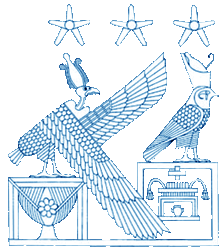
The spiritual world of the ancient Egyptians is not immediately understandable by the western civilizations of the twentieth century...We may find it ridiculous for artists to represent the sky as a cow, or for a beetle to be venerated as a symbol of the sun god, but in past ages, among peoples having a mythical view of the world, the formative principle was not of logic but of an outlook governed by images...The whole symbolic evocation rests upon the supposed, and in the end actual, correspondence of things, on the relationship between microcosm and macrocosm as intuitively understood by the mind and visually by the eye...The ancient Egyptians, the Babylonians, and to some extent the Greeks, used images; their view of the world was a comprehensive one.
The purpose of symbols is not to reveal the hidden relationships between earthly phenomena in a rationalistic way but rather to point to the irrational. Knowledge of cosmic order was one of the secrets which were withheld from the profane. The title 'Master of Secrets', common in the Old Kingdom, is to be understood in this way. A symbol is meant to direct the initiate to something higher and to reveal it to him at the same time, but it must also conceal this from the ignorant. Knowledge of the meaning of images was not accessible to everyone...A symbol has manifold significance and therefore its origin and purpose cannot often be explained satisfactorily. Sometimes the symbol seems to contradict itself. There are, in fact, symbols which refer to both poles of existence: life and death, good and evil.
Both concealed and revealed on this ancient artifact are many remarkable designs. Early astronomy is pictured here, including the stars Sirius and Sirius B, the constellations Canis Major, Argo, Bootes, Orion, Octans and others. Also, concealed and revealed is pre-Euclidean geometry. Earliest geometry and astronomy were interwoven and studied together as one great science. Early geometry involved the study of the vortex and the uses of the triangle in describing the properties of a circle and the geometry of the sphere for use in astronomy. The geometry shows the divine properties of light as contained within the holy circle. The properties of light also include its property of embeddedness, and this accounts in part for the spiral on the disk.
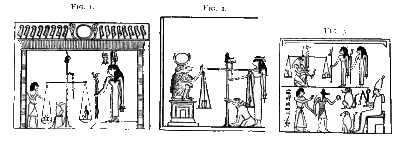
 When the Egyptian god Thoth (also known as Hermes, from which the word Hermeticism comes) weighs the heart of the newly-deceased against the weight of a feather (right, from the Egyptian Book of the Dead), it means the newly-deceased person is being measured ounce by ounce according to the deeds of a lifetime. Let us suppose we have died. Is our life over? Not according to the ancient Isis-Osiris myth. The jouney is only just beginning, and we have the life and death of Osiris' as a teaching about life in the afterlife and the part starlight has to play in this life and death drama.
When the Egyptian god Thoth (also known as Hermes, from which the word Hermeticism comes) weighs the heart of the newly-deceased against the weight of a feather (right, from the Egyptian Book of the Dead), it means the newly-deceased person is being measured ounce by ounce according to the deeds of a lifetime. Let us suppose we have died. Is our life over? Not according to the ancient Isis-Osiris myth. The jouney is only just beginning, and we have the life and death of Osiris' as a teaching about life in the afterlife and the part starlight has to play in this life and death drama.
As the ancient story goes, when god-king Osiris is killed and later dismembered by his mean and ambitious brother Typhon, many realities came into existence for Osiris, realities that need repair by Divine Mother Isis. She is the sister-wife of Osiris and a salvatory goddess who sails the celestial Nile of the night skies.
 When Osiris is killed by Typhon, somthing paradoxical happens; Osiris' immortality becomes evident. Immortality is represented at the center of the Cretan Phaistos Disk, Side 1, as the Flower of Life or lotus.
When Osiris is killed by Typhon, somthing paradoxical happens; Osiris' immortality becomes evident. Immortality is represented at the center of the Cretan Phaistos Disk, Side 1, as the Flower of Life or lotus.  The disk is pictured below, and our story unfolds as we move from the first symbol at the center of disk, following the symbols out in a spiral to the outer edge of Side 2 of the disk, then following those symbols inward in a spiral to the center of Side 2. The flower image, right, is shown protected by the goddess Mut, a vulture-version of Isis whose image Egyptians placed in tombs to protect the dead in their embryonic state of re-birth into the afterlife. Above Mut are the stars representing starlight of Sirius. (Fragment from an Egyptian limestone relief, drawing by Rockne Chandler Beeman)
The disk is pictured below, and our story unfolds as we move from the first symbol at the center of disk, following the symbols out in a spiral to the outer edge of Side 2 of the disk, then following those symbols inward in a spiral to the center of Side 2. The flower image, right, is shown protected by the goddess Mut, a vulture-version of Isis whose image Egyptians placed in tombs to protect the dead in their embryonic state of re-birth into the afterlife. Above Mut are the stars representing starlight of Sirius. (Fragment from an Egyptian limestone relief, drawing by Rockne Chandler Beeman)
This Flower of Life also corresponds to the flax flower, which plays a part in the ancient Egyptian religious practices. Egyptian priests wore linen things on account of the colour of the flax flower, according to the famous Greek biographer, essayist and initiate Plutarch (46? CE - 120? CE). The Egyptian priests "wear linen things on account of the colour which the flax in flower sends forth, resembling the aetherial radiance that surrounds the cosmos." (43) 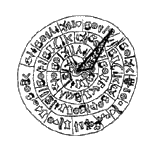 Another interesting syncretism relating to this pictograph is the triangle made when connecting the three flowers together that are found on Side 2. The image produced is a triangle resembling the constellation Octans, referencing the number 8. Octans is a constellation in the Southern hemisphere. We may take this syncretism a little further to see that Side 1 is perhaps a reference to the skies of the Southern Hemisphere. Three lotus/flax flowers with 8 petals are seen on Side 1; one on Side 2.
Another interesting syncretism relating to this pictograph is the triangle made when connecting the three flowers together that are found on Side 2. The image produced is a triangle resembling the constellation Octans, referencing the number 8. Octans is a constellation in the Southern hemisphere. We may take this syncretism a little further to see that Side 1 is perhaps a reference to the skies of the Southern Hemisphere. Three lotus/flax flowers with 8 petals are seen on Side 1; one on Side 2.
A figure 8 is seen on the next symbol found on the disk, moving from the center of the disk outward. This pictograph represents both Osiris  and the shaven-head priests of Isis-Osiris. The indication is that the priest, by association with Osiris, has the same degree of immortality of the god. On his cheek is the symbol of infinity, which is his Osirian symbol of beingness. He, above all others, is infinite in scope. He is beyond time, beyond space, and beyond all corruption of physicality. But he has yet to put on his crown because he has work to do. Like Osiris, he must cleanse the world of all its dark energies and bring to it the light of creation.
and the shaven-head priests of Isis-Osiris. The indication is that the priest, by association with Osiris, has the same degree of immortality of the god. On his cheek is the symbol of infinity, which is his Osirian symbol of beingness. He, above all others, is infinite in scope. He is beyond time, beyond space, and beyond all corruption of physicality. But he has yet to put on his crown because he has work to do. Like Osiris, he must cleanse the world of all its dark energies and bring to it the light of creation.
In ancient Egypt the god whose death and resurrection were annually celebrated with alternate sorrow and joy was Osiris, the most popular of all Egyptian deities...The story of Osiris is told in a connected form only by Plutarch, whose narrative has been confirmed and to some extent amplified in modern times by the evidence of the monuments...Osiris was the offspring of an intrigue between the earth-god Seb (Keb or Geb, as the name is sometimes transliterated) and the sky-goddess Nut. The Greeks identified his parents with their own deities Cronus and Rhea. When the sun-god Ra perceived that his wife Nut had been unfaithful to him, he declared with a curse that she should be delivered of the child in no month and no year. But the goddess had another lover, the god Thoth or Hermes, as the Greeks called him, and he playing at draughts with the moon won from her a seventy-second part of every day, and having compounded five whole days out of these parts he added them to the Egyptian year of three hundred and sixty days. This was the mythical origin of the five supplementary days which the Egyptians annually inserted at the end of every year in order to establish a harmony between lunar and solar time. On these five days, regarded as outside the year of twelve months, the curse of the sun-god did not rest, and accordingly Osiris was born on the first of them. At his nativity a voice rang out proclaiming that the Lord of All had come into the world. (The Golden Bough, Sir James George Frazer, 1922, Chapter 38, The Myth of Osiris)
 ...a voice (Logos) fell out together with him on his being brought forth-to wit: 'The Lord of all comes forth to light'" (17) His birth was heralded: "Great King Good-doing Osiris is born." (18)
...a voice (Logos) fell out together with him on his being brought forth-to wit: 'The Lord of all comes forth to light'" (17) His birth was heralded: "Great King Good-doing Osiris is born." (18)
Some say that a certain Pamyles heard a voice from the temple at Thebes bidding him announce with a shout that a great king, the beneficent Osiris, was born. But Osiris was not the only child of his mother. On the second of the supplementary days she gave birth to the elder Horus, on the third to the god Set, whom the Greeks called Typhon, on the fourth to the goddess Isis, and on the fifth to the goddess Nephthys. Afterwards Set married his sister Nephthys, and Osiris married his sister Isis.
Reigning as a king on earth, Osiris reclaimed the Egyptians from savagery, gave them laws, and taught them to worship the gods. Before his time the Egyptians had been cannibals. But Isis, the sister and wife of Osiris, discovered wheat and barley growing wild, and Osiris introduced the cultivation of these grains amongst his people, who forthwith abandoned cannibalism and took kindly to a corn diet. Moreover, Osiris is said to have been the first to gather fruit from trees, to train the vine to poles, and to tread the grapes. Eager to communicate these beneficent discoveries to all mankind, he committed the whole government of Egypt to his wife Isis, and travelled over the world, diffusing the blessings of civilisation and agriculture wherever he went. (The Golden Bough, Sir James George Frazer, 1922, Chapter 38, The Myth of Osiris)
"Now, as far as the 'many are concerned, even this commonest and smallest [secret] is hid from them--namely, why the priests cut off their hair  , and wear linen robes; for some do not at all care to know about these things, while others say that they abstain from [the use of] the sheep's wool, as they do from its flesh, because they hold it sacred, and that they shave their heads through being in mourning, and wear linen things on account of the colour which the flax in flower
, and wear linen robes; for some do not at all care to know about these things, while others say that they abstain from [the use of] the sheep's wool, as they do from its flesh, because they hold it sacred, and that they shave their heads through being in mourning, and wear linen things on account of the colour which the flax in flower  sends forth, resembling the aetherial radiance that surrounds the cosmos." (43)
sends forth, resembling the aetherial radiance that surrounds the cosmos." (43)
Appearing on Side 1 of the disk are two images of Osiris, also representing the priests and possibly representing, in another syncretism, "the priest An-maut-f, who has on the right side of his head the lock of Heru-pa-khrat, or Horus the Child, and who wears a leopard's skin." (ebod, p. 300) Beside each Osiris/Priest on Side 1 is the flax flower/lotus.
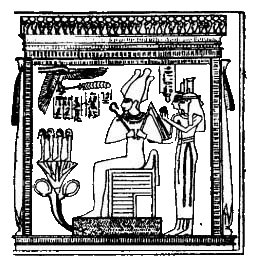 Osiris takes up his broom
Osiris takes up his broom  , his tool of purification, also his feather which is his knowledge of his divinity as weighed against the feather. He takes wing, sailing over the world. He shares his purity and he cleanses the world of all its woes, all its sorrows and its misguided concepts, all its loosely formed opinions and its unholy beliefs. And this he
does most admirably. He cleans up the entire planet, as well as the Universe, making it light as a feather, and he continues on his journey of purification because he knows most definitely his path is Good, his soul is Just, his
beingness is Confirmed. He is Osiris Most High and he is doing his given position of purifying the
world.
, his tool of purification, also his feather which is his knowledge of his divinity as weighed against the feather. He takes wing, sailing over the world. He shares his purity and he cleanses the world of all its woes, all its sorrows and its misguided concepts, all its loosely formed opinions and its unholy beliefs. And this he
does most admirably. He cleans up the entire planet, as well as the Universe, making it light as a feather, and he continues on his journey of purification because he knows most definitely his path is Good, his soul is Just, his
beingness is Confirmed. He is Osiris Most High and he is doing his given position of purifying the
world.
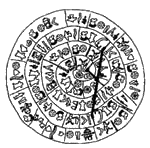 According to Plutarch, Osiris' name is derived from "sairein," meaning "sweep clean," in order to "beautify and adorn." (24) The sweep/feather of Osiris appears 4 times on Side 1. When connected, they produce an adjacent angle, two angles in the same plane which have a common vertex and a common side but have no interior points in common. Connected another way, they produce another version of the triangle that is created by connecting the three flax flowers together.
According to Plutarch, Osiris' name is derived from "sairein," meaning "sweep clean," in order to "beautify and adorn." (24) The sweep/feather of Osiris appears 4 times on Side 1. When connected, they produce an adjacent angle, two angles in the same plane which have a common vertex and a common side but have no interior points in common. Connected another way, they produce another version of the triangle that is created by connecting the three flax flowers together.
This image above, left, shows the flax flower/lotus from a side view. The flower was linked with the beginning of the world as a symbol of the unfolding of life. (The Gods and Symbols of Ancient Egypt, Manfred Lurker, Thames and Hudson, publishers, 1974, p.52) It is appropriate, then, that it should be stationed at the center of Side 1 of the disk. Standing upon it (above, left - below, right) are the four gods of the four directions that Osiris went when he cleansed the world. In this image, Isis and Nephthys stand behind Osiris, and all are facing the East and the morning sun that is represented in its aspect of son or Horus, the son of Osiris. The sun/son is symbolized by the falcon, the symbol of Horus, that is flying West towards Osiris, carrying in its claw the feather or sweep that cleanses the world and makes it light. In this arrangement of symbols, the lotus/flax flower comes to represent the earth--microcosm--with its four cardinal directions, and the entire image represents the universe--macrocosm.
When Osiris sets out to purify the world, he begins as a Divine Heaven-Walker 
 because his purpose is divine as is his person. This symbol also represents the initiate/priest of Osiris who goes forth as a newly born divine being in the image of the pure and immortal Osiris. He walks along most joyfully, loving himself in his physical body and his physical life, and in his physical job of maintenance man of the Universe. He is blessed in his position. The symbol to the right of the heaven-walker is the Egyptian hieroglyph for 'walking.'
because his purpose is divine as is his person. This symbol also represents the initiate/priest of Osiris who goes forth as a newly born divine being in the image of the pure and immortal Osiris. He walks along most joyfully, loving himself in his physical body and his physical life, and in his physical job of maintenance man of the Universe. He is blessed in his position. The symbol to the right of the heaven-walker is the Egyptian hieroglyph for 'walking.'
Osiris went "over the whole earth, cleaning it, 
![]() not in the least requiring arms, but drawing the multitude to himself by charming them with persuasion and reason, with song and every art the Muses give..." (26) Osiris as heaven-walker going over the whole earth appears 5 times on Side 2; 6 times on Side 1. Connecting this symbol on both sides of the disk produces polygons.
not in the least requiring arms, but drawing the multitude to himself by charming them with persuasion and reason, with song and every art the Muses give..." (26) Osiris as heaven-walker going over the whole earth appears 5 times on Side 2; 6 times on Side 1. Connecting this symbol on both sides of the disk produces polygons.
Beside the heaven-walker is a hieroglyph for the tall stalk of the Papyrus plant.  This image
This image ![]() is the Egyptian hieroglyph for papyrus, reversed. Because the papyrus plant was used for making writing paper, it symbolizes the intellect and dignity of one who could read and write. The Papyrus plant shows how brilliant is the Divine Osirian. He is truly brilliant and so also is completely trustworthy because of his brilliance. And he is spreading his brilliance through the written word. Part of the compositon of this papyrus plant is the wheat plant, portraying a sheaf of wheat. And because it represents another symbol, the phallus of Osiris, it is a pictograph with several correspondences. On side 1, the papyrus appears 3 times, each time with a heaven-walker/Osiris. On side 2, the papyrus appears 3 times, twice beside a heaven-walker/Osiris.
is the Egyptian hieroglyph for papyrus, reversed. Because the papyrus plant was used for making writing paper, it symbolizes the intellect and dignity of one who could read and write. The Papyrus plant shows how brilliant is the Divine Osirian. He is truly brilliant and so also is completely trustworthy because of his brilliance. And he is spreading his brilliance through the written word. Part of the compositon of this papyrus plant is the wheat plant, portraying a sheaf of wheat. And because it represents another symbol, the phallus of Osiris, it is a pictograph with several correspondences. On side 1, the papyrus appears 3 times, each time with a heaven-walker/Osiris. On side 2, the papyrus appears 3 times, twice beside a heaven-walker/Osiris. 

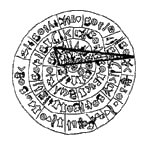 When connected, another trilateral figure is produced. "Of trilateral figures...an isosceles triangle is that which has two of its sides alone equal... (Euclid, give footnote) and "...a scalene triangle
When connected, another trilateral figure is produced. "Of trilateral figures...an isosceles triangle is that which has two of its sides alone equal... (Euclid, give footnote) and "...a scalene triangle 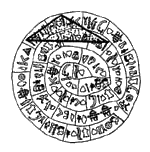 (3 Papyrus connected) that which has its three sides unequal."
(3 Papyrus connected) that which has its three sides unequal."
The next pictograph shows more information regarding Osiris and his place
of residence, his House, represented by  . This indicates he lives two places, above and below, by which is meant Osiris lives above, in the celestial Heavens, and below, in the netherworld. This pictograph has another correspondence. The 'E' derives from the ancient Sumerian symbol for House of the God and means, in this instance, House of Osiris. The 'E' marks the house of the god on top of the ziggurats in ancient Sumer. The Egyptian Book of the Dead was known to the Egyptian priests as The Book of the Master of the Secret House, references the house of Osiris as the great pyramid, otherwise called "Light." (9) From these correspondences, we gain the additional understanding that the house of Osiris is the light -- Osiris is star Sirius. 2 of these pictographs appear on Side 1. They function to give guidance about how to interpret the symbol following.
. This indicates he lives two places, above and below, by which is meant Osiris lives above, in the celestial Heavens, and below, in the netherworld. This pictograph has another correspondence. The 'E' derives from the ancient Sumerian symbol for House of the God and means, in this instance, House of Osiris. The 'E' marks the house of the god on top of the ziggurats in ancient Sumer. The Egyptian Book of the Dead was known to the Egyptian priests as The Book of the Master of the Secret House, references the house of Osiris as the great pyramid, otherwise called "Light." (9) From these correspondences, we gain the additional understanding that the house of Osiris is the light -- Osiris is star Sirius. 2 of these pictographs appear on Side 1. They function to give guidance about how to interpret the symbol following.
In geometry, the number two is represented by a straight line, having an angle of 180 degrees and a length defined as magnitude. "A line is a breadthless length." (13) The straight line may be the diameter of a circle,
"Parallel straight lines are straight lines which, being in the same plane and being produced indefinitely in both directions, do not meet one another in either direction." (15) Two or more straight lines, having no points in common, may be parallel and of the same magnitude.
The Thyrsuses may be a kind of herbal treatment designed to preserve the
body from wear and tear during the long journey home to Source and to Light. It could be an ancient herbal prescription or part of the secret formula for mummification and purification following death. Perhaps it was used in the mummification of priests or devotees of Isis and Osiris who were perceived to be bound for the celestial realms of Sirius. Osiris is building a house in the Light for those who will soon arrive after death. There they merge with him and became divine. Osiris is the being who can do all this because he is the Divine Creator of life-force herbs like the
Thyrsuses. This long Thyrsuses shows that possibility for Osiris and for ourselves. As he heaven-walks past the long Thyrsuses, he looks forward into the future to see himself purified, represented by the 5-branched tree or Chen-Osiris
But Osiris...was also a tree-spirit, and this may perhaps have been his primitive character, since the worship of trees is naturally older in the history of religion than the worship of the cereals. The character of Osiris as a tree-spirit was represented very graphically in a ceremony described by Firmicus Maternus. A pine-tree having been cut down, the centre was hollowed out, and with the wood thus excavated an image of Osiris was made, which was then buried like a corpse in the hollow of the tree. It is hard to imagine how the conception of a tree as tenanted by a personal being could be more plainly expressed. The image of Osiris thus made was kept for a year and then burned...The ivy was sacred to him, and was called his plant because it is always green. (The Golden Bough, Chapter 40)
The plant has 5 branches because it also represents the five-branched heather-tree that grew around the coffin of Osiris. From "the ancient Chaldaean mystery-tradition of the Fire, 'five-branched' would thus mean man, or rather purified man, and the saying referred to the pruning of this tree." (51)
The number five also is sacred because it symbolizes the hypotenuse of the "perfect" 3-4-5 triangle, the right triangle of the Pythagorean Theorem, divinized here 1200 years or so before Pythagoras proved it.
"For the 'three' is the first 'odd' and perfect; while the 'four' is square from side 'even' two; and the 'five' resembles partly its father and partly its mother, being composed of 'three' and 'two.'" (52)
"We must, accordingly, compare its (right triangle) perpendicular to male, its base to female, and its hypotenuse to the offspring of both; and [conjecture] Osiris as its source, Isis as receptacle, and Horus as result." (53)
"And panta [all] is only a slight variant of pente [five]; and they (the Egyptians) call counting pempasasthai [reckoning by fives]." (54)
The coffin came to rest against a heather-bush,
Among the constellations on Side 1 are Octans and Bootes. The body of Osiris
O ye children of Seb, overthrow ye the foes of Osiris (4) Ani, triumphant, destroy ye the adversaries of righteousness from the boat of Ra. Horus shall cut off your (5) heads in heaven in the likeness of ducks; ye shall fall down upon the earth and become beasts, and into the water in the likeness of fishes. (ebod, -329)
The pieces of Osiris may be the early, and probably first, representation of the Archons, the planetary rulers whose flayed and stretched out skins form the sky in much the same way the body of the Egyptian goddess Nut formed the sky. Egypt had a mystical astrology which included fantastic figures scattered across the skies, and this is portrayed by the disk, whereon the numerous signs are scattered across the skies of both the Northern (Side 2) and Southern (Side 1) Hemispheres.
ADD IN - Body is not only house but also tomb
In the above image, the Phaistos Disk as been placed at the center of the flying disk to give an idea of what might have been intended by the creators of the Phaistos Disk. They may have intended it as a sacred flying disk or Behudi-ti, the Egyptian word for winged disk. The Flying disk, with serpents on both sides, is like serpent-bird symbolism, referencing the indwelling ability of each human toward immortality. But it also comprises Merkaba concepts and companion ideas that we evolve through stages and that we learn to fly to that heavenly abode of Sirius. Given that Horus appears 20 times on the Phaistos Disk, 14 on Side 1 and 5 on Side 2, it would seem to be the Winged Disk of Horus.
Appearing beside Horus is a pictograph with several correspondeces. First, it is a shield and a symbol for the visible universe
"Each of the [Seven] Planetary Spheres is a complete World containing a number of divine offspring, which are invisible to us, and over all of these Spheres the Star (Sirius) we see is the ruler."(4)
The round shield to the right of the Hermetic Star contains the Ring Cosmos and Ring Chaos of Ring-Pass-Not (limits the spread of the fiery cosmos) and symbolizes the Limit of the Hebdomad, the material universe of the 7 lower spheres or planets. The two outer shields of the Vitriol Acrostic contain alchemical symbols in the form of mythical beasts connected by chains. They symbolize the planets as being "living creatures having bodies fastened by vital chains," (5) which hold them to the "appointed task of their orbits."
They believed the planets were divine beings and they also thought that powerful beings ruled the universe and that these beings lived above them in the stars
The 'divine offspring' of the planets (see the quote) are nonmaterial spheres or spiritual levels of planetary existence. Around the edge of the Riddle of the Stone, which has been associated with the Emerald Table of Hermes Trismegistus, is a Shamanic message meaning "visit the inward parts of earth; by rectifying thou shalt find the hidden [Philosopher's] Stone." The creator of the Riddle was Basil Valentine, the mysterious 16th century alchemist believed to have been a Benedictine monk.
Concealed on the Phaistos Disk is the singular image of the 7 planets surrounding the fixed star of Sirius. This image is revealed by placing a point at each shield (below) and connecting all but one of the points with lines. By this method, a star inside a heptagram emerges. The outside edge of the Phaistos Disk is traced around the heptagram design because the points inside the shields are encircled. A shield is at each point, showing the exact location of the shields on the disk. Revealed is the star Sirius with its companion star, Sirius B. Double every line and the point representing the companion becomes connected.
Concealed on the Phaistos Disk is the original Hermetic Star, the emblem of the ancient Egyptian and Cretan Hermeticists.
"In the Egyptian sense, it is SIRIUS the Dog-Star, the Star of Isis-Sothis. Around it are the Stars of the Seven Planets each with its seven-fold counterchanged operation." (8) This design has come down to us through time and is demonstrated on these images from modern Hermeticism. (below)
Top left, Keys in the Enochian Language by John Dee (16th c. CE) click on image for larger view; second from left, Osiris altar, Hermetic Order of the Golden Dawn, 20th c.; third from left, ceiling of the tomb of Christian Rosenkreuz, 18th c. CE, Roscicrucian; right, floor of the tomb of Christian Rosenkreuz, 18th c. CE, Roscicrucian; bottom left, Keys in the Enochian language, geometry design, bottom right, Hermetic Star of the Phaistos Disk.
By all these correspondences we can arrive at the decipherment of the shields of the Phaistos Disk. They represent the visible universe of the 7 planets. Later will be seen another syncretism associated with this pictograph. The round shield is accompanyed by the Horus symbol on the Phaistos Disk because this is the dark companion of the star Sirius known as Sirius B and because Sirius A and B are shown here as the two Eyes of Horus. This delineation of these two stars is made by joining together these visible universe signs on the Phaistos Disk.
 The long Thyrsuses probably belongs to a family of herbs and may be a sign of regeneration and life eternal. The length is important because it extends down into the next
circle or dimension on the Phaistos Disk and functions as a line segment. By connecting the two
The long Thyrsuses probably belongs to a family of herbs and may be a sign of regeneration and life eternal. The length is important because it extends down into the next
circle or dimension on the Phaistos Disk and functions as a line segment. By connecting the two  symbols, we can notice that the connecting line is parallel to the long line of the Thyrsuses, and this gives us pause to think about how this Thyrsuses symbol extends down into the next circle of the spiral. This extension becomes symbolic when we see that Osiris can regenerate himself to exist in full magnificence and potential in the next dimension of reality -- in the afterlife -- by extending himself and sharing himself out to all the cities of Egypt. The Thyrsuses also corresponds to the papyrus plant. The blending of the two plants makes sense, when one takes into consideration that the papyrus stands for intellect and the long thyrsuses, as preserved on the Phaistos Disk, stands for multidimensionality. In terms of Gnosis or knowledge of the divine, this is a teaching of certain beliefs delivered to us by plants!
symbols, we can notice that the connecting line is parallel to the long line of the Thyrsuses, and this gives us pause to think about how this Thyrsuses symbol extends down into the next circle of the spiral. This extension becomes symbolic when we see that Osiris can regenerate himself to exist in full magnificence and potential in the next dimension of reality -- in the afterlife -- by extending himself and sharing himself out to all the cities of Egypt. The Thyrsuses also corresponds to the papyrus plant. The blending of the two plants makes sense, when one takes into consideration that the papyrus stands for intellect and the long thyrsuses, as preserved on the Phaistos Disk, stands for multidimensionality. In terms of Gnosis or knowledge of the divine, this is a teaching of certain beliefs delivered to us by plants! At the festivals of Osiris in ancient Greece, according to Plutarch, the celebrants carried "thyrsuses," (87) "symbolic wands, generally cane-like or knotted like a bamboo, and sometimes wreathed with ivy or vine leaves, with a pine-cone at the top." (88) Part of the purpose of this symbol is that ...the discovery of wheat and barley was attributed to Isis, and at her festivals stalks of these grains were carried in procession to commemorate the boon she had conferred on men. (The Golden Bough, chap 41) Two thyrsi are seen on Side 1; two more on Side 2.
At the festivals of Osiris in ancient Greece, according to Plutarch, the celebrants carried "thyrsuses," (87) "symbolic wands, generally cane-like or knotted like a bamboo, and sometimes wreathed with ivy or vine leaves, with a pine-cone at the top." (88) Part of the purpose of this symbol is that ...the discovery of wheat and barley was attributed to Isis, and at her festivals stalks of these grains were carried in procession to commemorate the boon she had conferred on men. (The Golden Bough, chap 41) Two thyrsi are seen on Side 1; two more on Side 2.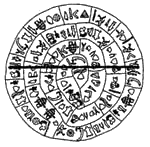 (2 thyrsi, Side 2, connected) which is "any straight line drawn through the centre and terminated in both directions by the circumference of the circle, and such a straight line also bisects the circle. The extremities of a line are points." (14)
(2 thyrsi, Side 2, connected) which is "any straight line drawn through the centre and terminated in both directions by the circumference of the circle, and such a straight line also bisects the circle. The extremities of a line are points." (14) 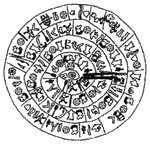 (2 E's, 2 Thyrsi, Side 1, connected)
(2 E's, 2 Thyrsi, Side 1, connected) ,
the ivy consecrated to Osiris.
,
the ivy consecrated to Osiris.  (47) that grew into a hearty and beautiful heather-tree because of the body of Osiris inside its trunk. The king of that country so admired the magnificent heather-tree that he cut it down and installed it in his palace as a pillar in the roof. (48) He left behind a tree-trunk with 5 branches. (49)
(47) that grew into a hearty and beautiful heather-tree because of the body of Osiris inside its trunk. The king of that country so admired the magnificent heather-tree that he cut it down and installed it in his palace as a pillar in the roof. (48) He left behind a tree-trunk with 5 branches. (49)  Seen 6 times on Side 2 of the disk and 5 times on Side 1 is the "chen-Osiris" or "Osiris-plant," the ivy consecrated to Osiris. (50)
Seen 6 times on Side 2 of the disk and 5 times on Side 1 is the "chen-Osiris" or "Osiris-plant," the ivy consecrated to Osiris. (50) Connecting them produces a polygon and the constellation Bootes.
Seen 6 times on Side 2 of the disk and 5 times on Side 1 is the "chen-Osiris" or "Osiris-plant," the ivy consecrated to Osiris. (50)
Seen 6 times on Side 2 of the disk and 5 times on Side 1 is the "chen-Osiris" or "Osiris-plant," the ivy consecrated to Osiris. (50) Connecting them produces a polygon and the constellation Bootes.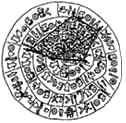
 was chopped into 14 pieces by his brother Typhon. This pictograph appears 15 times on this Cretan Phaistos Disk and has several correspondences. The body of Osiris symbolizes that portion of the god-man that is physical and is unable to transcend the limitations of physical matter. The 14 pieces of Osiris' dismembered body corresponded to the 14 days of the waning moon. (Gods and Goddesses, p. 82) The 15th body of Osiris may symbolize his immanent shareability and his own ability to regroup
himself into a large coherent form and pattern. By this is meant, Osiris can reform his position within
himself and then re-start or regenerate his own body. This is an immortality concept held by the ancient Egyptians and Cretans as well as others of that era.
was chopped into 14 pieces by his brother Typhon. This pictograph appears 15 times on this Cretan Phaistos Disk and has several correspondences. The body of Osiris symbolizes that portion of the god-man that is physical and is unable to transcend the limitations of physical matter. The 14 pieces of Osiris' dismembered body corresponded to the 14 days of the waning moon. (Gods and Goddesses, p. 82) The 15th body of Osiris may symbolize his immanent shareability and his own ability to regroup
himself into a large coherent form and pattern. By this is meant, Osiris can reform his position within
himself and then re-start or regenerate his own body. This is an immortality concept held by the ancient Egyptians and Cretans as well as others of that era. The body of Osiris
The body of Osiris  perhaps represents the imiut, which is the ancient Egyptian term given to the fetish consisting of a headless animal skin hung on a pole that was stuck into a pot, for protection. Animal skins were an important requisite for one's outward appearance when one wished to achieve a final inner transformation, therefore a skin was a symbol of a transitional state. Three fox skins were used as the written sign birth. (Gods and Goddesses, p. 26) This skin perhaps represents the hide of a bull. ...the bullock's hide, in which the deceased, or the person who represented him, was supposed to wrap himself..(Ebod, p. 259)
perhaps represents the imiut, which is the ancient Egyptian term given to the fetish consisting of a headless animal skin hung on a pole that was stuck into a pot, for protection. Animal skins were an important requisite for one's outward appearance when one wished to achieve a final inner transformation, therefore a skin was a symbol of a transitional state. Three fox skins were used as the written sign birth. (Gods and Goddesses, p. 26) This skin perhaps represents the hide of a bull. ...the bullock's hide, in which the deceased, or the person who represented him, was supposed to wrap himself..(Ebod, p. 259) Horus (Horus-in-Sirius), is the son/sun of Osiris and Isis. He is "the avenger of his father, and his coming forth is his birth. The plumes upon his head are Isis and Nephthys when they go forth to set themselves there, even as his protectors, and they provide that which his head lacketh..." (67) After the death of Osiris his son Horus succeeded him as king of Egypt. All Egyptian royal symbolism was founded on the complementary ideas that Osiris was the last dead king and Horus the king 'on the throne of the living'. Thus each royal rule must have appeared to the simple believer as the rule of a god king. To his subjects the king was the visible incarnation of the god Horus. (Gods and Goddesses, p. 10) Perhaps this symbolism was adopted by the Cretans and by King Minos, ruler of Minoan Crete.
Horus (Horus-in-Sirius), is the son/sun of Osiris and Isis. He is "the avenger of his father, and his coming forth is his birth. The plumes upon his head are Isis and Nephthys when they go forth to set themselves there, even as his protectors, and they provide that which his head lacketh..." (67) After the death of Osiris his son Horus succeeded him as king of Egypt. All Egyptian royal symbolism was founded on the complementary ideas that Osiris was the last dead king and Horus the king 'on the throne of the living'. Thus each royal rule must have appeared to the simple believer as the rule of a god king. To his subjects the king was the visible incarnation of the god Horus. (Gods and Goddesses, p. 10) Perhaps this symbolism was adopted by the Cretans and by King Minos, ruler of Minoan Crete. ![]() The head-dress of Horus is the double crown or double crown of feathers. "When not identifed by the inscription accompanying them most Egyptian gods and goddesses can be identified by their individual headdresses, although at times several deities can share the same type." (Gods and goddesses, p67)
The head-dress of Horus is the double crown or double crown of feathers. "When not identifed by the inscription accompanying them most Egyptian gods and goddesses can be identified by their individual headdresses, although at times several deities can share the same type." (Gods and goddesses, p67)
 In the beginning Horus was imagined to be a sky god whose image was seen as that of a falcon with outstretched wings, whose eyes were regarded as the sun and moon…Since not only the sky, but the sun also, were seen as a falcon, the king, sun and sky became identified and this found its final expression as the royal symbol of the winged disc. (gods and goddesses, p. 65)
In the beginning Horus was imagined to be a sky god whose image was seen as that of a falcon with outstretched wings, whose eyes were regarded as the sun and moon…Since not only the sky, but the sun also, were seen as a falcon, the king, sun and sky became identified and this found its final expression as the royal symbol of the winged disc. (gods and goddesses, p. 65)
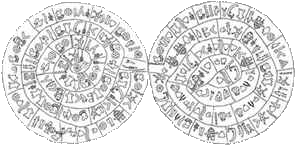 The eyes of Horus perhaps were conceived of as Sirius A and Sirius B, and the Phaistos Disk represents the two eyes of Horus. Side 1 is the solar side, with the flower sign in the center. Side 2 is the lunar side with the star and nile sign in the center, representing the night skies. Put the two sides together, as marked, and they produce the figure 8 on the cheek of priest of Osiris.
The eyes of Horus perhaps were conceived of as Sirius A and Sirius B, and the Phaistos Disk represents the two eyes of Horus. Side 1 is the solar side, with the flower sign in the center. Side 2 is the lunar side with the star and nile sign in the center, representing the night skies. Put the two sides together, as marked, and they produce the figure 8 on the cheek of priest of Osiris. 





















 . The shield contains 6 dots in the shape of the hexagram. According to the Egyptian astronomers, the visible universe was the 7 planets and the star Sirius. On Side 1 of the disk are 15 round shields, each containing 7 dots. By placing Sides 1 and 2 of the disk together (below left) as indicated by the matching line segments on the outer shells of each side, the famous Figure 8 shield of ancient Crete is produced. (below right)
. The shield contains 6 dots in the shape of the hexagram. According to the Egyptian astronomers, the visible universe was the 7 planets and the star Sirius. On Side 1 of the disk are 15 round shields, each containing 7 dots. By placing Sides 1 and 2 of the disk together (below left) as indicated by the matching line segments on the outer shells of each side, the famous Figure 8 shield of ancient Crete is produced. (below right) The 7 dots within the shields of the disk form a hexagon
The 7 dots within the shields of the disk form a hexagon  . The dots inside the shields represent the 7 planets known at that time, including the sun and the moon and excluding Earth; they are Saturn, Jupiter, Mars, Mercury and Venus. A round shield almost identical to those of the Phaistos Disk is seen on the Riddle of the Stone, also known as the Vitriol Acrostic (below), which alchemists, after the 16th century, held in superstitious reverence.(1) (The Vitriol Acrostic may be the alchemical descendant of the ancient frescoes of the Atum-cult period in Egypt which show "the sun sending forth rays, each furnished with a hand for giving and blessing." (2) Alchemy began in Egypt, which was once called Chemmis. "They call Egypt Chemia," (3) or Chem-Egypt, hence Alchemy.) Readers familiar with alchemy can look back at the first image of Chapter Three, in which the goddess Mut shields the flower, and recognize alchemical meaning.
. The dots inside the shields represent the 7 planets known at that time, including the sun and the moon and excluding Earth; they are Saturn, Jupiter, Mars, Mercury and Venus. A round shield almost identical to those of the Phaistos Disk is seen on the Riddle of the Stone, also known as the Vitriol Acrostic (below), which alchemists, after the 16th century, held in superstitious reverence.(1) (The Vitriol Acrostic may be the alchemical descendant of the ancient frescoes of the Atum-cult period in Egypt which show "the sun sending forth rays, each furnished with a hand for giving and blessing." (2) Alchemy began in Egypt, which was once called Chemmis. "They call Egypt Chemia," (3) or Chem-Egypt, hence Alchemy.) Readers familiar with alchemy can look back at the first image of Chapter Three, in which the goddess Mut shields the flower, and recognize alchemical meaning. 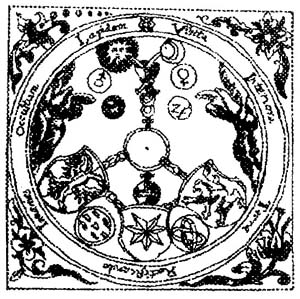 On the Riddle of the Stone (left, Illus. 1) are various symbols for the 7 planets. Top left are 7 small circles representing the 7 planets; top center are 7 symbols, one for each planet; and at the bottom are various shields. Almost identical to the shields on the disk is the round shield, bottom left, within which are 7 dots of hexagonal arrangement representing the 7 planets. To the right of this shield is the 7-pointed Hermetic Star, each of the 7 points representing one of the 7 planets, with the center point representing star Sirius.
On the Riddle of the Stone (left, Illus. 1) are various symbols for the 7 planets. Top left are 7 small circles representing the 7 planets; top center are 7 symbols, one for each planet; and at the bottom are various shields. Almost identical to the shields on the disk is the round shield, bottom left, within which are 7 dots of hexagonal arrangement representing the 7 planets. To the right of this shield is the 7-pointed Hermetic Star, each of the 7 points representing one of the 7 planets, with the center point representing star Sirius.
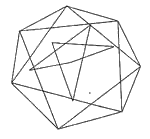
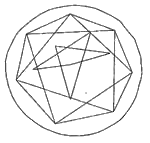
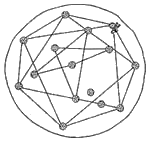
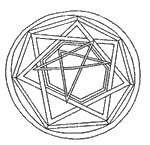
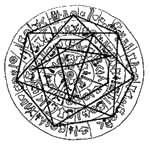
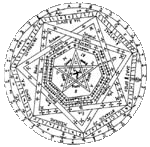
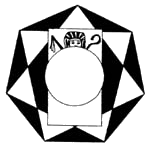
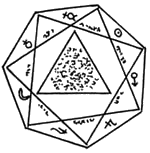
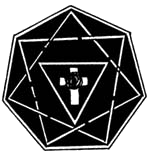
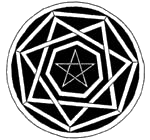
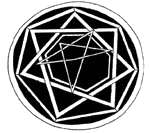
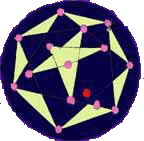 This design is known in modern Hermeticism as the Hermetic Star -- the star
Sirius in the center of the 7 planets -- derived, of course, from the ancient Hermeticism which we are studying right now. Alongside the star and to the bottom right is its invisible companion, Sirius B. It would seem the Cretans at least detected the dark companion, as did the Dogon tribesmen in Africa. In modern metaphysics, overlapping hexagrams form the Merkaba symbol of the Star Tetrahedron.
This design is known in modern Hermeticism as the Hermetic Star -- the star
Sirius in the center of the 7 planets -- derived, of course, from the ancient Hermeticism which we are studying right now. Alongside the star and to the bottom right is its invisible companion, Sirius B. It would seem the Cretans at least detected the dark companion, as did the Dogon tribesmen in Africa. In modern metaphysics, overlapping hexagrams form the Merkaba symbol of the Star Tetrahedron.
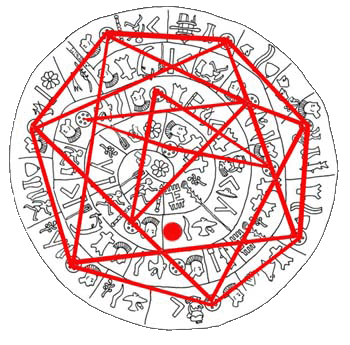
The Hermetic Star of Isis-Sothis and the Face of Horus at the center of the Star
Page 1 - Where I Left Off | The Starlight Chronicles
The Human Brain | The Star Sirius
Regenerative Properties of Starlight
Page 2 - A Vague Remembrance | Weighing the Soul
Page 3 - Transcendent Reality | Being One with Nature
Page 4 - Creative Energy | Number Philosophy
Meanings of the Pictographs